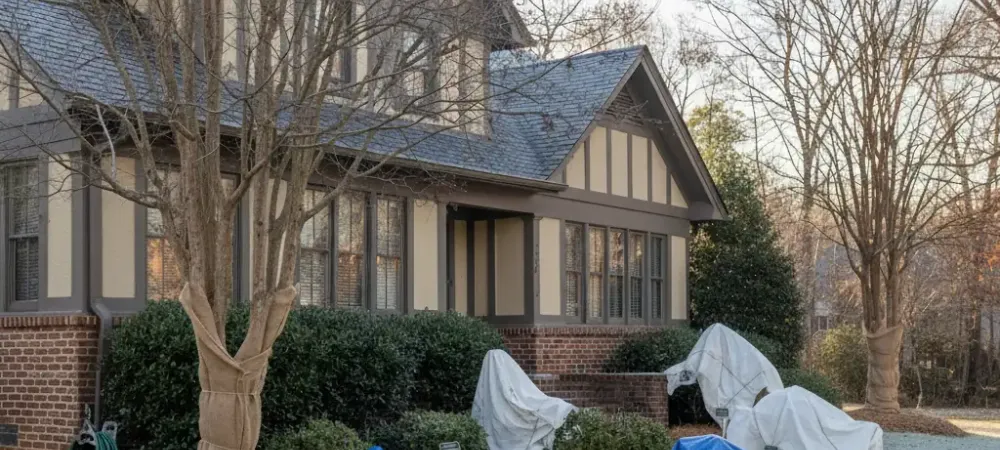
How to Protect Trees and Shrubs from Winter Freeze in Georgia
Georgia winters often bring unpredictable temperature drops that can catch homeowners off guard, given their milder weather expectations. While the region generally experiences warm conditions, cold snaps that dip below freezing pose a significant threat to trees and shrubs. Without proper preparation, plants can suffer damage that delays growth, reduces vigor, or even causes death. This guide provides authoritative, actionable steps specific to Georgia’s climate to help you protect your landscape against winter freeze stress.
Quick Answer
To protect trees and shrubs from winter freezes in Georgia, deeply water plants before cold snaps, mulch the roots to insulate them, cover vulnerable plants with breathable fabrics like burlap or frost cloth (avoiding plastic), and delay pruning until after the frost risk has passed. These proven methods reduce freeze injury and strengthen plant recovery in spring.
Why Winter Freeze Protection Matters in Georgia
Georgia’s climate varies from mountainous northern regions to warm southern areas, but sudden freezes can occur statewide. Rapid downward temperature swings create freeze-thaw cycles that rupture plant cells, causing leaf burn, bark splitting, or dieback. “Sudden freezing temperatures are more likely to injure plants not fully acclimated to cold weather” (University of Georgia Extension). Proper winter protection helps plants acclimate and withstand damaging cold spells, safeguarding your investment in your landscape while ensuring healthy regrowth in spring.
How to Protect Trees and Shrubs: Detailed Steps for Georgia
1. Identify Freeze-Susceptible Plants in Your Landscape
Start by recognizing plants that are less tolerant to freezing temperatures, such as young trees, broadleaf evergreens, and many ornamentals like camellias, gardenias, or citrus, which stand at the highest risk. The mountains may demand more protection due to lower temperatures, but even metro Atlanta sees cold snaps that can harm sensitive species. Prioritize protection based on plant type and location within your property’s microclimates.
2. Deeply Water Before Cold Weather Arrives
Soil moisture dramatically affects temperature retention. Dry soil cools quickly and exposes roots to harsh freeze. Water trees and shrubs deeply one or two days before a forecasted freeze, ideally during the morning to allow soil drainage before nightfall. Moist soil retains heat more effectively, insulating the roots and reducing freeze injury. Consistent fall watering encourages healthy tissue development and cold acclimation.
3. Mulch Generously to Insulate Roots
Spread 2 to 3 inches of organic mulch, such as pine straw, shredded bark, or compost, around the base of trees and shrubs, extending it out to the drip line. Mulch moderates soil temperature fluctuations, protects roots from freeze penetration, and retains moisture. Ensure mulch does not touch the trunk directly to prevent rot and pests. According to the University of Georgia Extension, “a well-mulched bed retains soil warmth, shielding roots from freeze penetration”. Renew mulch layers in late fall for optimal effect.
4. Cover and Wrap Vulnerable Plants
For smaller shrubs and young trees, covering plants before nightfall traps ground heat and reduces frost damage. Use breathable materials like burlap, frost cloth, or sheets; avoid plastic sheeting, which traps moisture and can cause plant injury during thawing (UGA Forsyth Extension). Secure coverings with stakes or rocks to prevent wind displacement. For thin-barked young trees, wrap trunks with tree wrap or burlap to reduce split bark from sudden temperature shocks. Remove coverings promptly after freeze periods to allow airflow and prevent the buildup of disease.
5. Prune at the Right Time
Avoid heavy pruning in late fall, as it stimulates tender new growth that is vulnerable to freezing temperatures. Instead, prune dead or damaged branches after the last frost threat passes, usually in early spring in Georgia. This practice helps plants conserve energy during winter and reduces the risk of freeze injury.
6. Choose Cold-Hardy and Native Species for Long-Term Landscape Resilience
If freeze damage is recurring, consider replacing susceptible plants with native or cold-hardy species that are adapted to Georgia’s climate zones. American holly, camellias, yaupon holly, and red maple offer strong cold tolerance, complemented by year-round beauty. Matching your landscaping to the correct USDA hardiness zone reduces the risk of winter injury and maintenance costs over time (USDA Plant Hardiness Map).
7. Use Windbreaks and Microclimate Knowledge
Cold air tends to settle in low-lying areas, often making the north and northwest sections of yards colder. Position sensitive plants near southern exposures or near structures and larger plants that buffer wind chill. Installing burlap or garden fabric windbreaks around delicate shrubs can further reduce freeze damage from chilling winds common in Georgia winters.
Options and Methods: Choosing the Right Protection for Your Situation
- Mulching provides broad root-zone insulation, which is essential for in-ground plants, and is less labor-intensive.
- Wrapping and covering help protect delicate above-ground foliage and young trunks, but require removal after freezing events.
- Water spraying during a freeze (ice formation releases heat) is sometimes used commercially, but is impractical for most homeowners due to the need for repeated overnight applications.
- Windbreaks and site assessments optimize natural protection and should be combined with physical coverings for optimal results.
Each method can be strategically combined based on the plant species, location, and severity of the freeze. For instance, mature trees benefit most from mulching and site planning, while container plants or newly planted shrubs require covers and frequent monitoring during cold snaps.
Prevention Tips for Long-Term Success
- Avoid fall fertilizing with high nitrogen to prevent tender, late growth that is sensitive to cold.
- Regularly test soil nutrients to ensure balanced feeding for healthy plant metabolism during cold acclimation.
- Improve soil drainage to prevent root rot and freeze damage.
- Maintain mulch layers and replace annually to retain insulation quality.
- Inspect plant covers after storms and secure them firmly against the wind.
- Monitor plants early in spring for freeze damage and prune only dead or damaged limbs later.
When to Call Professionals
Severe winter damage signs include bark splitting, persistent dieback, or fungal growth post-freeze. If your trees or shrubs show these symptoms, consult certified arborists or local lawn care specialists experienced in Georgia’s climate. They can assess recovery potential and recommend remediation or replacement strategies. Residential freeze protection services are also available to help prepare your landscape ahead of expected freezes. Visit our Tree & Shrub Care Services page to schedule an expert evaluation and winter protection plan tailored for Georgia homeowners.
Safeguard Your Landscape This Winter
Georgia’s variable winters require strategic winterizing of trees and shrubs to prevent freeze damage. By assessing plant vulnerability, mulching roots, watering properly, and covering sensitive plants with breathable materials, you can safeguard your landscape from cold stress and enjoy vibrant spring growth. If you want professional help protecting your yard this winter or need a thorough landscape inspection, contact us today for expert winter plant care services designed for Georgia’s unique climate.
Sources:
- University of Georgia Extension. “Protect Landscape Plants and Vegetable Seedlings from Frost.” 2025. https://fieldreport.caes.uga.edu/news/protect-landscape-plants-vegetable-seedlings-from-frost/
- North Carolina Cooperative Extension. “Protecting Plants During Cold Weather.” 2024. https://henderson.ces.ncsu.edu/2024/11/protecting-plants-during-cold-weather/
- USDA Plant Hardiness Zone Map. United States Department of Agriculture. 2024. https://planthardiness.ars.usda.gov
- UGA Extension Forsyth County. “Protect Plants from Winter Freezes.” 2024. https://site.extension.uga.edu/forsyth/2024/12/protect-plants-from-winter-freezes/



